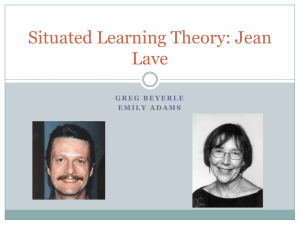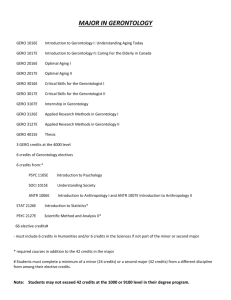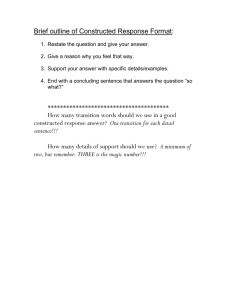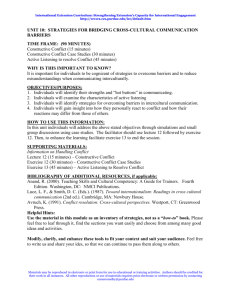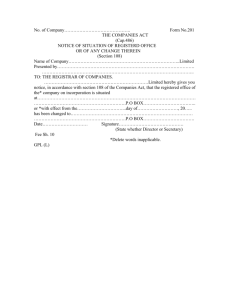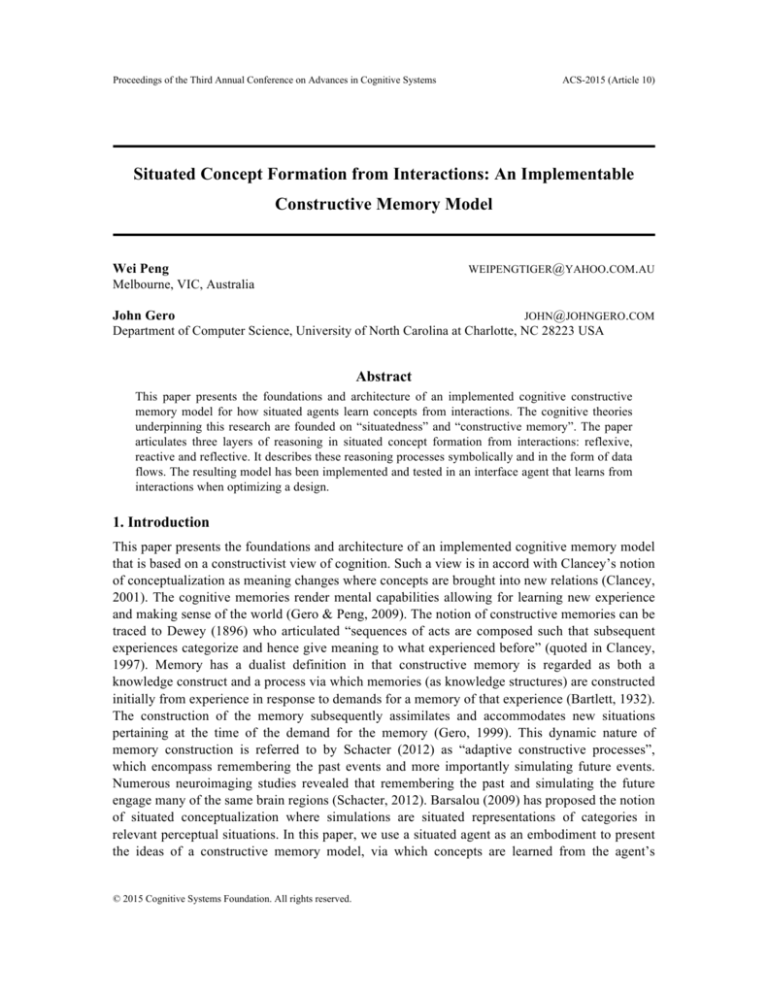
Proceedings of the Third Annual Conference on Advances in Cognitive Systems
ACS-2015 (Article 10)
Situated Concept Formation from Interactions: An Implementable
Constructive Memory Model
Wei Peng
Melbourne, VIC, Australia
WEIPENGTIGER@YAHOO.COM.AU
John Gero
JOHN@JOHNGERO.COM
Department of Computer Science, University of North Carolina at Charlotte, NC 28223 USA
Abstract
This paper presents the foundations and architecture of an implemented cognitive constructive
memory model for how situated agents learn concepts from interactions. The cognitive theories
underpinning this research are founded on “situatedness” and “constructive memory”. The paper
articulates three layers of reasoning in situated concept formation from interactions: reflexive,
reactive and reflective. It describes these reasoning processes symbolically and in the form of data
flows. The resulting model has been implemented and tested in an interface agent that learns from
interactions when optimizing a design.
1. Introduction
This paper presents the foundations and architecture of an implemented cognitive memory model
that is based on a constructivist view of cognition. Such a view is in accord with Clancey’s notion
of conceptualization as meaning changes where concepts are brought into new relations (Clancey,
2001). The cognitive memories render mental capabilities allowing for learning new experience
and making sense of the world (Gero & Peng, 2009). The notion of constructive memories can be
traced to Dewey (1896) who articulated “sequences of acts are composed such that subsequent
experiences categorize and hence give meaning to what experienced before” (quoted in Clancey,
1997). Memory has a dualist definition in that constructive memory is regarded as both a
knowledge construct and a process via which memories (as knowledge structures) are constructed
initially from experience in response to demands for a memory of that experience (Bartlett, 1932).
The construction of the memory subsequently assimilates and accommodates new situations
pertaining at the time of the demand for the memory (Gero, 1999). This dynamic nature of
memory construction is referred to by Schacter (2012) as “adaptive constructive processes”,
which encompass remembering the past events and more importantly simulating future events.
Numerous neuroimaging studies revealed that remembering the past and simulating the future
engage many of the same brain regions (Schacter, 2012). Barsalou (2009) has proposed the notion
of situated conceptualization where simulations are situated representations of categories in
relevant perceptual situations. In this paper, we use a situated agent as an embodiment to present
the ideas of a constructive memory model, via which concepts are learned from the agent’s
© 2015 Cognitive Systems Foundation. All rights reserved.
W. PENG AND J. S. GERO
interactions with its environment. A situated agent is a software agent built using the notion of
“situatedness” which has its roots in empirical naturalism (Dewey, 1896) and cognitive
psychology (Bartlett, 1932). An agent uses a constructive memory model to continuously create
and adapt concepts whilst interacting with a dynamic environment (Gero & Peng, 2009).
Concepts as bearers of meaning and their formation are essential products that emerge from this
cognitive apparatus giving rise to the system’s adaptive behaviors, which can be characterized as
“reflexive”, “reactive” and “reflective” behaviors (Maher & Gero, 2002).
The theoretical grounds for this constructive memory model are briefly presented in Section 2
which revolves around notions of “situatedness” and “constructive memory”. Section 3 details the
situated concept formation process and relating data flows in the framework of constructive
memory. Section 4 concludes the paper with discussions of computational implementation
scenarios.
2. Situatedness and Constructive Memory
The theory of “situatedness” claims that human thought and action adapt to their environment.
They are situated because of what people perceive, how people conceive of their activity, and
what people physically do develop together (Clancey, 1997). It is postulated in situated learning
that knowledge should be viewed as a capacity to coordinate and sequence behaviors, to adapt
dynamically to changing circumstances (Clancey, 1995). In this vein, “situatedness” entails both
the environment and the observer’s experiences and the interactions between them.
“Situatedness” is paraphrased as “where you are when you do what you do matters” (Gero, 1998),
being inseparable from interactions in which knowledge is dynamically constructed.
“Situatedness” is related to “Situated Action” (Suchman, 1987), “Situated Cognition” (Clancey,
1997) and “Situated Learning” (Lave and Wenger, 1991). The notion of “situatedness” is
considered as a conditio sine qua non for any form of “true” intelligence, natural or artificial
(Lindblom & Ziemke, 2002). Vygotsky enriched the concept of “situatedness” by introducing
activity theory, defining that activities of the mind cannot be separated from overt behavior, or
from the social context in which they occur. Social and mental structures interpenetrate each other
(Vygotsky, 1978; Clancey, 1995).
Situated cognition describes the way humans construct their internal worlds via their
interactions with the external world (Gero, 2003).
The external world, in Figure 1, denotes the world that consists of external events. The
interpreted world is the world constructed inside the agent. This internal world is composed of
sensory, perceptual and conceptual experiences, and created through the work of interpretation.
The expected world is derived from the interpreted world. Through a process called focusing, the
agent is able to use some aspects of the interpreted world, for example, concepts, to derive
anticipations that predict future states of the external world. The process of action affects the
external world based on anticipations constructed in the agent’s self-organized focusing or
refocusing processes.
2
SITUATED CONCEPT FORMATION FROM INTERACTIONS
External
World
Interpretation
Reinterpretation
Action
Expected
World
Focusing
Refocusing
Interpreted
World
(within Interpreted
World)
Figure 1. Situatedness as interaction of three worlds (after Figure 2 of Gero and Kannengiesser (2004)).
We hold that “situatedness” not only can be presented as recursive linkages between these
three worlds, it is also often accompanied by structural and behavioral adaptation in the internal
worlds. An external change may cause changes in the interpreted world. This can be achieved by
activating or intentionally reactivating the agent’s experience. With reinterpretations, the agent
can further refocus or produce a new concept to affect the external world.
Central to this situated agency is the notion of “constructive memory”. Memory in
computational systems often refers to a place that holds data and information called “memories”.
It is indexed so as to be queried more efficiently afterwards. We utilize a different notion of
memory. Clancey (1991) emphasized that memory is not a place where descriptions of what we
have done or said before are stored, but is indistinguishable from our capability to make sense, to
learn a new skill, to compose something new. This is the essence of Bartlett’s model of
constructive memory (Bartlett, 1932). The theory of constructive memory is supported by
cognitive and neuroscience studies (Von Foerster, 1970 reprinted in 2003; Reigler, 2005;
Schacter, 2012). The basic functions of a constructive memory are described by Riegler (2005)
as:
• the cognitive apparatus creates a structure;
• it interacts with other structures (such as the surrounding environment or the older structure
of its apparatus);
• it compares the newly created structures with those encountered in its interactions with other
structures; and
• it adapts the structures when needed before returning to the first function.
Reigler's (2005) constructive memory functions emphasize changes of knowledge structures
during a construction process. However, the lack of fine-grained descriptions of a cognitive
architecture leads to speculations of how the structures are constructed and adapted. A more
detailed description of the characteristics of a constructive memory can be found in (Gero, 2006):
• memory is a reasoning process;
• the index need not be explicit, it can be constructed from the query;
3
W. PENG AND J. S. GERO
•
•
•
•
•
the index can be changed by its use;
the content can be changed by its use;
the memory structure can be changed by its use;
memories can be constructed to fulfil the need to have a memory; and
memories are a function of the interactions occurring at the time and place of the need to have
a memory.
A memory can be regarded as a process of learning or reinforcing a concept. It is a reflection
of how the system has adapted to its environment (Gero & Smith, 2006). Such memories are
associated with both the previous memories (called “experiences” when used in the current
situation), and the current need for a memory (in terms of environment stimuli) (Gero, 2006). A
constructive memory system is an unsupervised incremental learning system, where all later
memories have the potential to include and affect all earlier memories while earlier memories
affect later memories (Gero, 2006). Two operational characteristics of a constructive memory
model are constructive learning and experiential grounding mechanisms (Liew & Gero, 2004).
Constructive learning is the means by which an agent develops new experiences. It has an effect
that potentially brings changes in the structure of the memory system (Alberini, Milekic, et al.
2006; Nader, 2003; Tanabe & Mogi, 2006). Experiential grounding is the mechanism providing
meanings to the experiences processed by an agent (Alberini, Milekic, et al. 2006; Liew & Gero,
2004). It is similar to historical grounding (Nehaniv & Dautenhahn, 1998), which accounts for the
consequence of the utility of an experience in determining its meaning. According to Liew and
Gero (2004), the basic operations for a constructive memory model consist of:
1. cueing: the memory system is initially cued by a demand from the current situation;
2. activation and selection: multiple experiences are activated, with only one being selected;
3. memory construction: memory is constructed based on the selected experience;
4. incorporation: the constructed memory is incorporated into the system; and
5. grounding: providing meanings to the activated experience based on the consequence of its
usage.
In the next section, we present a detailed schema of a constructive memory model and how
concepts are constructed.
3. Situated Concept Formation in a Constructive Memory Architecture
Concept formation has been regarded as a process of incremental unsupervised acquisition of
categories and their intentional descriptions (Fisher & Pizzani, 1991). Based on this view, a broad
spectrum of computational models has been developed, including inductive learning methods,
explanation-based learning approaches and connectionist algorithms. Theories of concept
formation reduced to categorization are not able to address the complexity of the world (Bisbey &
Trajkovski, 2005). A concept lacking an understanding of why the object, entity or event has its
particular properties is called a proto-concept instead (Vygotsky, 1986; Bisbey & Trajkovski,
2005). Learning a concept inherently entails understanding its influence on its environment. It is
postulated that concepts that incrementally capture the knowledge of a dynamic process are
4
SITUATED CONCEPT FORMATION FROM INTERACTIONS
formed as a consequence of “situatedness” (Gero & Fujii, 2000; Peng & Gero, 2006a; Smith &
Gero, 2005).
3.1 Information Processing of Sense-data, Percepts
The basic data structures that are used in concept formation are sense-data, sensory data, percept
and memory cue. Sense-data are environment variables and their states that are captured by
sensors. The sense-data are generated by sensors through “push” and “pull” processes. A push
process is a data-driven process in which changes from the external world trigger changes in the
agent’s internal world, for example, the agent’s experience. A pull process is an expectationdriven process in which the agent changes the internal world based on the expectation-biased
external changes (Gero & Fujii, 2000; Gero & Kannengiesser, 2006). The push and pull processes
can occur during processes of sensation, perception and conception. The pushed sense-data are
also called exogenous sense-data (Se). They are triggered by external environmental changes, for
example, mouse clicks performed by designers in using the computer-aided design tool. The
pulled sense-data are intentionally collected during the agent’s expectation-driven process. In the
pull process, sensors are triggered from the agent’s higher level processes (that is, perception,
conception) and use environmental changes to change their sense-data.
Sensory data consist of two types of variables: the exogenous sense-data (Se) and the
autogenous sensory experience (Sa). Sa is created from activating the agent’s memory structures
using the exogenous sense-data (Se). Sensory data, also called sensory-experience data, (Se+a) are
a combination of the agent’s exogenous sense-data (Se) and the related autogenous information
(Sa).
Percepts are intermediate data structures that are generated from mapping sensory data into
categories. A memory cue refers to a stimulus that can be used to activate the agent’s memories.
A cue is subsequently assigned with an activation value to trigger responses from the agent’s
memory structures.
3.2 Proto-concepts and Concepts
A concept is a result of an interaction process in which meanings are attached to environmental
stimuli. The term “proto-concept” is used to describe the intermediate state of a concept. A protoconcept is a memory structure that depicts the agent’s interpretations and anticipations about its
external and internal environment at a particular time. A concept is defined as the grounded
invariants over the agent’s experience. They are abstractions of experience of memories which
were utilized that confer a predictive ability for new situations (Rosenstein & Cohen, 1998; Smith
& Gero, 2000). On the other hand, a concept contains context-dependent specifications for an
abstraction which are encapsulated in anticipations. An agent focuses on parts of its experience to
produce a proto-concept, depicting its interpretation and expectation for the related environmental
changes (also called stimuli). The concept formation process involves a process of validation for
the constructed proto-concepts. An ill-formed proto-concept triggers a process (later referred as
‘Reflection’) in which the agent reasons and refocuses on a new proto-concept. A validated protoconcept forms a concept.
5
W. PENG AND J. S. GERO
3.3 Situated Concept Formation in Interactions
Interactions are fundamental bases for the concept formation process in a situated agent. This
paper draws ideas from the concept formation framework of Gero and Fujii (2000). Interactions
are modelled at two levels. Macro-level interaction is the means via which data can be transferred
between the agent and its environment. Micro-level interaction details the coordination of the
agent’s internal processes. The macro-level interactions provide a set of resources for the agent to
use in learning and constructing situational memory. The macro-level interactions and the agent’s
micro-level interactions form a coupled interaction mechanism that gives rise to the system’s
adaptive behaviors, which are defined as “reflexive”, “reactive” and “reflective” behaviors
(Maher & Gero, 2002).
3.4 Constructive Memory Architecture for Situated Agents
A situated agent contains sensors, effectors, grounded memory structures and concept formation
related processes consisting of paralleled sensation, perception, conception, hypothesizing,
expectation, validation, consolidation and action processes, shown in Figure 2.
The sensor is the instrument by which the agent receives and gathers stimuli from the
environment. The agent gains access to the environment through the sensors and affects the
environment through its effectors. An effector is the instrument by which the agent changes the
environment through its actions.
Action
Constructed
Memory
Structure
Validation
Memory
Activation
Effector
Events
Consolidation
Effects
Expectation
Time
Hypothesizing
Grounded
Memory
Structure
Conception
Perception
Sensation
Memory
Structures
Agent
Concept Formation
Processes
Sensor
Memory
Construction
Stimuli
Environment
Figure 2. The constructive memory model for a situated agent.
Sensation is the process of transforming sense-data into expected sensory experience data,
called Se+a in 3.1. Perception is the process of generating percepts from sequencing and coupling
6
SITUATED CONCEPT FORMATION FROM INTERACTIONS
sensory data. Perception maps sensory data to predefined category descriptions, and can generate
new information from the transformation of stimuli sensed (Clancey, 1997). Perception also
structures these sensory data into a sequence or simultaneous chunks (percepts) based on past
sequences, coupled categorizations (perceptual experiences) and activated abstractions of
percepts (proto-concepts). Perception is a “data-driven” and “expectation-driven” process in
which percepts are constructed from the synthesizing of expected percepts with current percepts
caused by environmental changes. Once environmental changes are sensed and structured into
sensory data, they are processed by expectation and grouped into current percepts.
Conception is the process of categorizing perceptual sequences and chunks in order to form
proto-concepts. Conception is implemented by three basic functions: conceptual labelling (C1),
constructive learning (C2) and induction (C3). The conceptual labelling function selects existing
proto-concepts based on memory responses to an environment cue. This includes deriving
expectations from the responses and identifying the target (focusing). Constructive learning
allows the agent to accumulate environment data. Induction generalizes patterns from the
captured data and is responsible for generating conceptual knowledge structures.
Expectation produces the agent’s predictions about environment events. Expectation reflects
on the agent’s view about possible consequences from certain actions. When unexpected events
are recognized, the agent engages in reinterpretation (Gero & Fujii, 2000; Kelly & Gero, 2014).
Reinterpretation is implemented in the hypothesizing process, in which focused concepts are
selected for expectation and the causalities of failures are activated. The hypothesizing process
generates a hypothesis from current learned proto-concepts, allowing the agent to learn in a “trial
and error” manner. An agent needs to refocus on or construct a new proto-concept to produce a
new hypothesis.
Action is the process in which the activated memories are experimented on within the current
environment to achieve goals. The feedback from the environment can serve as cues for
adjustment of the agent’s behaviors.
Validation is the process in which the agent verifies proto-concepts and hypotheses. It
examines the deviation of the concepts and expectation with environment changes. A valid
concept will be reinforced in consolidation, in which the memory structures of valid concepts are
strengthened in that the likelihood of the consolidated memories being activated in similar
circumstances is enhanced.
3.5 Micro-level Interaction
Central to a situated agent is the micro-level interaction schema, which denotes how an agent’s
internal processes coordinate with one another in attaching meanings to low-level sense-data, and,
as a consequence, contributes to the agent’s behaviors. Table 1 indicates data flows that will be
further illustrated in this section.
Se is captured by sensors as a sequence of unlabelled raw stimuli and is sent to Sensation
(label 1 in Table 1 and Figure 3).
7
W. PENG AND J. S. GERO
Table 1. Data flows notation for a situated agent. Numbered data flows are referred to in Figures 3 to 8.
1
2
3
4
5
6
7
8
9
10
11
sending sense-data (Environment variables) from
sensor to Sensation
sending sense-data, current percept and concept to
Expectation which will further activate memory
structures to generate an expected sensory data,
percepts and concepts
activating memory structures to create a response
12
sending command to activate Sensation
13
Sending current percept to Conception
14
sending activated memory to Action
sending sensory data to Perception to generate
percepts
sending action plans to drive Effector to change the
environment
pulling current sensory data from Sensation
pulling current sense-data from Sensor
15
16
creating constructed memory from current protoconcept at runtime
sending constructed memory to Action
sending constructed memory to Validation
17
pulling current proto-concept to Hypothesizing
18
19
sending expected percept, pulled sense-data and
sensory data to Validation
sending validation result to Consolidation
20
pulling current percept to Conception
pulling grounded memory to Hypothesizing or
activating grounded memory from Hypothesizing
sending hypothesis to Conception
21
activating Conception to perform inductive
learning function
sending command to strengthen the validated
memory structures
An environmental stimulus is captured by a sensor which is transformed into sense-data. This
denotes the effect of a push process in Figure 3.
Expectation
Grounded
Memory
Structure
2
Perception
3
5
2
4
Action
Sensation
6
1
Effector
Sensor
Push
Environment
Data Structures
Functions
Data Flows
Environment
Figure 3. Interactions that drive the reflexive behavior (numbers refer to Table 1).
8
SITUATED CONCEPT FORMATION FROM INTERACTIONS
Take for example the visual, somatic and olfactory stimuli for an orange:
• Se(t) = {…… “stimuli of round yellow object”, “rough skin surface”, “specific smell”……}.
Based on the memory of sensory modality information of “orange”, the agent creates an
autogenous variable with its initial label for the Se from its expectation: (Sensation → “2” →
Expectation → “3” → Grounded Memory Structure (Sensory Modalities) → “3” → Expectation
→ “2” in Figure 3):
• Sa(t) = {“Assignment of Modalities to stimuli”}.
Thus, sensory data Se+a takes the form in Sensation as:
• Se+a(t) = {…… [“vision of round yellow object”, “touch of rough skin”, “smell like
orange”]……}
The sensory data Se+a can be further categorized to create initial percept Pi based on its
grounded memories relating to categories (Perception → “2” → Expectation → Grounded
Memory (Categories) → Expectation → “2” in Figure 3). The initial percept can be structured as
a triplet “P (Perceptual Category, Sensory Modalities, Sensory Stimuli)”. It is expressed as:
• Pi(t) = { Orange, Orange Modality, “vision of orange”- “touch of orange”-“smell of orange”}
Reflexive behavior is produced when the experiential response to current sensed data is
sufficiently strong to reach a reflexive threshold. A memory response to a perceptual category can
affect action directly (“4”). In this circumstance, the agent reflexes to environment stimuli based
solely on its experience. This is generated from data flows which are illustrated in Figure 3. The
agent uses the activated memories to organize acts to bring changes to the environment (“6” →
“Effector” → “Environment”). At the same time, Perception initiates the “pull” process (“7” in
Figure 4) to validate the current formed percept that contains the agent’s expectation of
environmental changes.
The agent pulls data from its external macro-interactions and alters its interactions, Figure 4.
“Push” processes which are driven from “data-driven” commands run parallel with the
expectation-driven “pull” process, so that the agent’s internal processes can access real time data.
A validation function uses the expected percept that was derived from the activated memories
(in Figure 3) to activate “Perception” to pull data from its lower level process ((“7” in Figure 4).
A new version of percept is created based on the pulled sense-data (“Perception” ← “Pull” +
“7” ← “Sensation” ← “Pull” + “8” ← “Sensor”). The validation function measures the
discrepancy between the agent’s predictions and the environment changes by comparing this
pulled percept with the expected percept created at a previous time.
A consolidation function strengthens the valid experience through a flow – “Validation” →
“10” → “Consolidation” → “11” → “Grounded Memory Structure”. An invalid expectation
causes the agent to shift its behavior to stand-by and to capture additional data from the
environment (“Consolidation” → “12” → “Sensation”).
When the agent’s experiential response to the current sensed and perceived data is not strong
enough to reach the reflexive threshold, the agent moves into the reactive behavior mode. This
behavior is produced by micro-level interactions that are described in Figure 5. A percept at
9
W. PENG AND J. S. GERO
runtime can act as a memory cue that activates the agent’s grounded memory structures (“2” →
“Expectation” → “Grounded Memory Structure”). Based on the experiential response, the agent
generates an expectation for the current percept and creates a proto-concept (“13” →
“Conception” → “2” → “Expectation” → “3” → “Grounded Memory Structure” →
“Expectation” → “Conception”). The agent uses the proto-concept to construct a memory,
representing a response to current situation (“Conception” → “14” → “Constructed Memory
Structure”). The constructed memory structure is transferred to an action function and produces
an effect on the environment (via “15” → “Action” → “6” → “Effector” → “Environment”).
The agent subsequently examines the constructed memory in its macroscopic interactions with
the environment.
Validation
9
11
Consolidation
Pull
7
10
Grounded
Memory
Structure
Perception
12
Sensation
8
Pull
Sensor
Pull
Environment
Data Structures
Functions
Data Flows
Environment
Figure 4. The agent’s micro-interaction pulls data from macro-interactions and alters the interactions which
further alters the agent’s behavior.
The agent matches this memory with the current pulled percept1 (“16” + “9” →
“Validation”), Figure 6. Based on the validity of that memory, it either consolidates that memory
into experience (via “11” → “Grounded Memory Structure”) or initiates a reflective behavior
(“12” → “Sensation”).
Reflective behavior is activated by discrepancies between the constructed memory and the
current environmental changes – the failure of the system’s reactive behavior. In its reflective
1
The pull process is activated by the validation function to draw environment changes and the interpreted perceptual
categories of these changes.
10
SITUATED CONCEPT FORMATION FROM INTERACTIONS
behavior, the agent coordinates all its internal processes in two forms of interactions (Reflections
I and II) to reinterpret environmental changes. The “Reflection I” is triggered by circumstances
when the agent’s constructed proto-concepts fail in the validation function. The agent reactivates
its memories at a later time when a memory cue is able to be identified in the environment. This
uses similar data flows depicted in Figure 5. The agent then validates its reactivated memories
which represent the agent’s re-interpretation and re-expectation. If the agent fails to validate the
constructed proto-concepts, it activates “Reflection II” interactions, Figure 7.
14
Conception
Constructed
Memory
Structure
Expectation
2
13
2
Perception
2
5
15
3
Grounded
Memory
Structure
Action
Sensation
6
1
Effector
Sensor
Push
Environment
Data Structures
Functions
Data Flows
Environment
Figure 5. Micro-interactions that drive reactive behavior.
“Reflection II” involves the agent’s conceptual level experience (in the grounded memory
structure) and hypothesizing process to deduce explanations (hypothesis) for the current
circumstances and construct a new proto-concept. A hypothesizing process draws data from a
lower level conception process, which in turn pulls data from perception and sensation (via
“Hypothesizing” ← “Pull” + “17” ← “Conception” + “Pull” ← …… ← “Environment”). It also
takes conceptual knowledge in the grounded memory structure as inputs (“19”).
The generated hypotheses represent the agent’s reinterpretation about environment changes.
In the meantime, the agent uses its hypotheses to refocus on a memory structure (through
“Hypothesizing” → 19 → “Grounded Memory Structure” → “3” → “Expectation” →
“Conception”). In this way, the hypotheses can be used by “Conception” to form new protoconcepts, via which new memories are formed.
11
W. PENG AND J. S. GERO
Constructed
Memory
Structure
16
Validation
9
Pull
7
10
11
Perception
12
Consolidation
Grounded
Memory
Structure
Sensation
8
Pull
Sensor
Pull
Environment
Data Structures
Data Flows
Functions
Environment
Figure 6. Pulling data from macro-interaction and validating the constructed concept in reactive behavior.
Receiving positive feedback from the macro-level interaction of the system, the agent
consolidates the proto-concept into grounded memory structures (“11” in Figure 8). An
unsupported proto-concept triggers a constructive learning process, in which the agent develops a
new grounded memory structure (via “21” → “Conception” → “14” → “Constructed Memory
Structure” → “11” → “Ground Memory Structure” in Figure 8).
12
SITUATED CONCEPT FORMATION FROM INTERACTIONS
14
Pull 17
19
Hypothesizing
Constructed
Memory
Structure
Conception
20
18
2
Pull
Perception
Expectation
3
Pull
7
15
Action
Grounded
Memory
Structure
Sensation
8
Pull
Sensor
Effector
Pull
Environment
Data Structures
Environment
Data Flows
Functions
Figure 7. Reflection II involves conceptual experience and the hypothesizing process to reinterpret a
situation.
14
Conception
18
Constructed
Memory
Structure
16
10
11
Grounded
Memory
Structure
Validation
11
9
21
Pull
Perception
Pull
7
Sensation
Consolidation
8
Pull
Sensor
Pull
Environment
Data Structures
Functions
Data Flows
Environment
Figure 8. Verifying and consolidating (incorporating) proto-concepts constructed from Reflection II.
13
W. PENG AND J. S. GERO
4. Conclusion and Discussion on Implementation
The cognitive foundation of situated concept formation has roots in theories of “situatedness”
(Dewey, 1896) and “constructive memory” (Bartlett, 1932). Situatedness connects concept
formation to the environment, while constructive memory is the basis of a situated memory
formation and adaptation system. This paper presents a framework that contributes to bridging the
gap between cognitive theories and computational implementable cognitive models by describing
detailed structures and information processes. The software implementation based on this model
has focused on two levels: the component and schema levels. At a component level, data
structures provide concept formation functions relating to sensation, perception, conception,
hypothesizing, expectation, validation, consolidation and action. The schema level is used to
represent reasoning behaviors illustrated as micro-interaction in Section 3.5. It is coded in the
main class of the software package which uses multi-threading to coordinate components of the
system to generate “Reflexive”, “Reactive” and “Reflective” behaviors. The lower-level
processing components of “Sensor”, “Preceptor” transform raw data into initially labeled
categories which are used to create a cue for a memory based on experience. The “Experience” is
implemented as an extended Interactive Competitive Neural Network (IAC), proposed by
McClelland (1981; 1995), to model the associative nature of perceptual experience (Gero & Peng,
2006b). The “Concepter” is implemented as a decision-tree learning algorithm to generalize the
cued perceptual experience into a proto-concept. The “Concepter” is also accumulates new
instances of concepts, for example, sequences of percepts and the associated target concept. The
“Hypothesizer” enables an agent to reflect and perform explanation-based learning. It is modelled
as a rule-based engine (Bigus & Bigus, 1998), which takes the focused concept as input and
applies backward chaining to re-focus on a new concept. The “Validator” verifies the usefulness
of a proto-concept against the environmental changes. A feature-based matching function serves
this end. The “Consolidator” is used to enhance the weight of edges of an IAC neural network, so
that neurons that were fired together are more likely to be activated at a later time. The “Effector”
can take the form of a standard graphic display when implemented in a human computer
interaction scenario. It takes the results produced and presents them to the user. The
implementation and behavior of a situated interface agent that uses constructive memory to learn
concepts from interactions in design optimization have been elaborated in Gero & Peng (2009).
In summary, the current paper has presented the model of an implementable constructive
memory based on cognitive constructs within a situated agent framework. Such a constructive
memory model can learn new concepts through its interactions. As a consequence the agent
develops adaptive behaviors through adapting memories and constructing memory structures.
Acknowledgements
This research is supported by a grant from the National Science Foundation, grant no. CMMI1400466 and from the Australian Research Council, grant no. DP0559885. Any opinions,
findings, and conclusions or recommendations expressed in this material are those of the authors
and do not necessarily reflect the views of the National Science Foundation or of the Australian
Research Council.
14
SITUATED CONCEPT FORMATION FROM INTERACTIONS
References
Alberini, C. M., M. H. Milekic, et al. (2006). Mechanisms of memory stabilization and
destabilization. Cellular and Molecular Life Sciences (CMLS), 63(9), 999-1008.
Barsalou, L.W. (2009). Simulation, situated conceptualization, and prediction. Phil. Trans. R.
Soc. B 364, 1281-1289.
Bartlett, F.C. (1932, reprinted in 1977). Remembering: A Study in Experimental and Social
Psychology. Cambridge: Cambridge University Press.
Bigus, J.P. and Bigus, J. (1998). Constructing Intelligent Agents with Java: A Programmer's
Guide to Smarter Applications, NY: John Wiley & Sons, Inc.
Bisbey, P.R. & Trajkovski, G.P. (2005). Rethinking Concept Formation for Cognitive Agents.
Working Paper, Towson University.
Clancey, W. (1991). Review of Rosenfield’s “The Invention of Memory”. Artificial Intelligence
50(2), 241-284.
Clancey, W. (1995). A tutorial on situated learning. Proc. Int. Conf. Computers and Education,
pp. 49-70. Charlottesville, VA: AACE.
Clancey, W. (1997). Situated Cognition: On Human Knowledge and Computer Representations.
Cambridge: Cambridge University Press.
Clancey, W. (2001). Is Abstraction a Kind of Idea or How Conceptualization Works. Cognitive
Science Quarterly 1. 389–421.
Dewey, J. (1896, reprinted in 1981). The reflex arc concept in psychology. Psychological Review,
3, 357–370.
Fisher, D.H. & Pizzani, M. (1991). Computational models of concept learning. In Concept
Formation: Knowledge and Experience in Unsupervised Learning (Fisher, D.H., Pazzani, M.J.
& Langley, P., Ed.), pp. 3–43. San Mateo, CA: Morgan Kaufmann.
Gero, J.S. (1998). Conceptual designing as a sequence of situated acts. In Artificial Intelligence in
Structural Engineering (Smith, I., Ed.), pp. 165–177. Berlin: Springer.
Gero, J.S. (1999). Constructive memory in design thinking. In Design Thinking Research
Symposium: Design Representation (Goldschmidt, G. & Porter W., Ed.), pp. 29-35.
Cambridge:MIT.
Gero, J.S. (2003). Design tools as situated agents that adapt to their use. Proc. 21st Int. eCAADe
Conf., pp. 177–180. Austria: Graz University of Technology.
Gero, J.S. (2006) Understanding situated design computing: Newton, Mach, Einstein and
quantum mechanics. In Intelligent Computing in Engineering and Architecture (Smith, IFC,
Ed.), pp. 285-297. Berlin:Springer.
Gero, J.S. & Fujii, H. (2000). A computational framework for concept formation in a situated
design agent. Knowledge-Based Systems, 13(6), 361–368.
Gero, J.S. & Kannengiesser, U. (2004). The situated function-behavior-structure framework.
Design Studies, 25(4), 373-391.
Gero, J.S. & Kannengiesser, U. (2006). A framework for situated design optimization. In
Innovations in Design Decision Support Systems in Architecture and Urban Planning
(Leeuwen, J.V. & Timmermans, H., Ed.), pp. 309-324. Berlin: Springer.
15
W. PENG AND J. S. GERO
Gero, J.S. & Peng, W. (2009). Understanding the behaviors of a situated agent: A Markov chain
analysis, Knowledge-Based Systems, 22(8), 610-621.
Gero, J.S. & Smith, G.J. (2006). A computational framework for concept formation for a situated
design agent, Part B: Constructive memory. Working Paper. Key Centre of Design Computing
and Cognition, University of Sydney.
Kelly, N. and Gero, J.S. (2014). Interpretation in design: Modelling how the situation changes
during design activity, Research in Engineering Design, 25(2), 109-124.
Lave, J. & Wenger, E. (1991). Situated Learning: Legitimate Peripheral Participation.
Cambridge: University of Cambridge Press.
Liew, P. & Gero, J.S. (2004). Constructive memory for situated agents, Artificial Intelligence for
Engineering Design, Analysis and Manufacturing, AIEDAM 18(2), 163-198.
Lindblom, J. & Ziemke, T. (2002). Social situatedness: Vygotsky and beyond. In Proc. 2nd Int.
Workshop on Epigenetic Robotics: Modeling Cognitive Development in Robotic Systems
(Prince, C.G., Demiris, Y., Marom, Y., Kozima, H. & Balkenius, C., Ed.), pp. 71–78.
Edinburgh, Scotland.
Maher, M.L. & Gero, J.S. (2002). Agent models of 3D virtual worlds. Proc. ACADIA 2002, pp.
127–138. Pomona, CA: California State Polytechnic University.
McClelland, J.L. (1981). Retrieving general and specific information from stored knowledge of
specifics. Proc. Third Annual Meeting of the Cognitive Science Society, pp. 170–172. Hillsdale,
NJ: Erlbaum.
McClelland, J.L. (1995). Constructive memory and memory distortion: A parallel distributed
processing approach. In Memory Distortion: How Minds, Brains, and Societies Reconstruct the
Past (Schacter, D.L., Ed.), pp. 69–90. Cambridge, Massachusetts: Harvard University Press.
Nader, K. (2003). Memory traces unbound. Trends Neurosci, 26, 65–72.
Nehaniv, C. & Dautenhahn, K. (1998). Embodiment and memories – Algebras of time and history
for autobiographic agents. Proc. 14th European Meeting on Cybernetics and Systems Research,
EMCSR'98, pp. 651-656.
Peng, W. & Gero, J.S. (2006a). Concept formation in a design optimisation tool. In Innovations in
Design Decision Support Systems in Architecture and Urban Planning (Leeuwen, J.V. &
Timmermans, H., Ed.), pp. 293–308. Berlin: Springer.
Peng, W. & Gero, J.S. (2006b). Using a constructive interactive activation and competition neural
network to construct a situated agent’s experience. In PRCAI 2006: Trends in Artificial
Intelligence (Qiang Y. & Webb G., Ed.), pp. 21–30. Springer.
Riegler, A. (2005). Constructive Memory. Kybernetes, 34(1/2), 89-104.
Rosenstein, M.T. & Cohen, P.R. (1998). Concepts from time series. Proc. Fifteenth National
Conf. Artificial Intelligence, pp. 739–745.
Schacter, D.L. (2012). Adaptive constructive processes and the future of memory. American
Psychologist, 67, 603-613.
Smith, G. & Gero, J.S. (2000). The autonomous, rational design agent. Workshop on Situatedness
in Design, Artificial Intelligence in Design '00, pp. 19–23. Worcester, MA.
Smith, G. & Gero, J.S. (2005). What does an agent mean by being “situated”? Design Studies, 26,
535-561.
16
SITUATED CONCEPT FORMATION FROM INTERACTIONS
Suchman, L.A. (1987). Plans and Situated Actions: The Problem of Human-machine
Communication, Cambridge: Cambridge University Press.
Tanabe, F. & Mogi, K. (2006). Lability of reactivated human declarative memory. Neural
Information Processing, 4232, pp. 147-154.
Von Foerster, H. (1970 reprinted in 2003). Thoughts and Notes on Cognition. In Understanding
Understanding (Von Foerster, H. Ed.), pp. 169-190. NY: Springer.
Vygotsky, L.S. (1978). Mind in Society: The Development of Higher Psychological Processes.
Cambridge, MA: Harvard University Press. (Original work published in 1934.)
Vygotsky, L.S. (1986). Thought and Language. Cambridge, Mass: MIT Press.
Nomenclature for internal interaction schema
Ac – actions and suggestions
Ca – constructive learning activation signal
Cd – consolidated experience or newly constructed memory
Ci – initial proto-concepts
Cj – current formed proto-concepts
E – the agent’s effects on the environment
Ec – expected proto-concepts
Ef – expectation based on reflexive experience
Ep - expectation based on reactive experience
Hs – hypothesis
Mc – constructed memory
Nc – focused proto-concepts or new constructed proto-concepts
Pa – pulling activation signal
Pc – the pulled proto-concepts
Pev – the pulled exogenous variables
Pi – initial percepts
Pj – current formed percepts
Pp – the pulled percepts
Ps – the pulled sensory data
Ra – reactivating experience signal
Rc – reflective conceptual experiences
Re – reactive perceptual experience
Rf – reflexive experiences refer to strong experiences that directly affect actions
Sa – autogenous variables from sensory experience
Se – sense-data captured by sensors
Se+a – a combination of exogenous and autogenous sensory data
Vd – validation result
17


